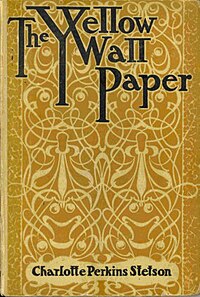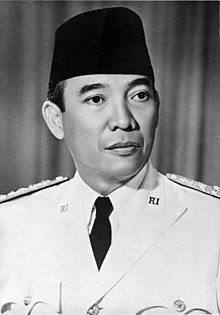 |
| Marapi 2891 mdpl,sungguh suatu keindahan yg tidak bsa di jelaskan dengan kata,begitu menabjukkan |
climbing mountain
Minggu, 11 November 2018
"The Yellow Wallpaper" (original title: "The Yellow Wall-paper. A Story") is a short story by American writer Charlotte Perkins Gilman, first published in January 1892 in The New England Magazine.[1] It is regarded as an important early work of American feministliterature, due to its illustration of the attitudes towards mental and physical health of women in the 19th century.
| "The Yellow Wallpaper" | |
|---|---|

1899 edition cover
| |
| Author | Charlotte Perkins Gilman |
| Country | United States |
| Language | English |
| Genre(s) | Captivity narrative,feminist literature |
| Publication date | 1892 |
Narrated in the first person, the story is a collection of journal entries written by a woman whose physician husband (John) has rented an old mansion for the summer. Forgoing other rooms in the house, the couple moves into the upstairs nursery. As a form of treatment, the unnamed woman is forbidden from working, and is encouraged to eat well and get plenty of air, so she can recuperate from what he calls a "temporary nervousdepression – a slight hysterical tendency", a diagnosis common to women during that period.[2][3][4]
Plot summaryEdit
The story details the descent of a young woman into madness. Her supportive, though misunderstanding husband, John, believes it is in her best interests to go on a rest cureafter experiencing symptoms of "temporary nervous depression". The family spends the summer at a colonial mansion that has, in the narrator's words, "something queer about it". She and her husband move into an upstairs room that she assumes was once a nursery. Her husband chooses for them to sleep there due to its multitude of windows, which provide the air so needed in her recovery. In addition to the couple, John's sister Jennie is present; she serves as their housekeeper. Like most nurseries at the time the windows are barred, the wallpaper has been torn, and the floor is scratched. The narrator attributes all these to children, as most of the damage is isolated to their reach. Ultimately, though, readers are left unsure as to the source of the room's state, leading them to see the ambiguities in the unreliability of the narrator.
The narrator devotes many journal entries to describing the wallpaper in the room – its "yellow" smell, its "breakneck" pattern, the missing patches, and the way it leaves yellow smears on the skin and clothing of anyone who touches it. She describes how the longer one stays in the bedroom, the more the wallpaper appears to mutate, especially in the moonlight. With no stimulus other than the wallpaper, the pattern and designs become increasingly intriguing to the narrator. She soon begins to see a figure in the design, and eventually comes to believe that a woman is creeping on all fours behind the pattern. Believing she must try to free the woman in the wallpaper, the woman begins to strip the remaining paper off the wall.
After many moments of tension between John and his sister, the story climaxes with the final day in the house. On the last day of summer, she locks herself in her room to strip the remains of the wallpaper. When John arrives home, she refuses to unlock the door. When he returns with the key, he finds her creeping around the room, circling the walls and touching the wallpaper. She asks excitedly, "I've got out at last,...in spite of you and Jane?", and her husband faints as she continues to circle the room, stepping over his inert body each time she passes, seeming to have become the personification of the woman trapped behind the yellow wallpaper.
Sabtu, 10 November 2018
HISTORY OF SOEKARNO
Sukarno[a] (/suːˈkɑːrnoʊ/;[2] born Kusno Sosrodihardjo, Javanese: [kʊsnɔ]; 6 June 1901 – 21 June 1970)[3] was the first President of Indonesia, serving from 1945 to 1967.
Sukarno was the leader of his country's struggle for Independence from the Netherlands.
He was a prominent leader of Indonesia's nationalist movement during
the Dutch colonial period, and spent over a decade under Dutch detention
until released by the invading Japanese
forces. Sukarno and his fellow nationalists collaborated to garner
support for the Japanese war effort from the population, in exchange for
Japanese aid in spreading nationalist ideas. Upon Japanese surrender,
Sukarno and Mohammad Hatta
declared Indonesian independence on 17 August 1945, and Sukarno was
appointed as first president.
HOW TO READ THE CRYSTAL
Any attempt at a scientific explanation of the phenomenon of "crystal seering," to use an irregular but comprehensive term, would perhaps fall short of completeness, and certainly would depend largely upon the exercise of what Professor Huxley was wont to call "the scientific imagination." The reasons for this are obvious. We know comparatively little about atomic structure in relation to nervous organism. We are informed to a certain degree upon atomic ratios; we know that all bodies are regarded by the physicist as a congeries of atoms, and that these atoms are "centres of force." Primarily, the atomic theory would refer all heterogeneous bodies to one homogeneous substance, from which substance, by means of a process loosely referred to as "differentiation," all the elements are derived. These elements are the result of atomic arrangement, and the atoms of each are known to have various vibrations, the extent of which is called the "mean free path of vibration." The indestructibility of matter, the fact that all nature is convertible, and the absolute association of matter and force, lead to the conclusion that since every change in matter implies a change of force, matter must be ever living and active, and primarily of a spiritual nature. The great Swedenborg, no less a scientist than a spiritual seer, laid down his doctrine of "Correspondences" upon the primary concept of the spiritual origin of all force and matter. Matter, he argued, was the ultimate expression of Spirit, as Form was that of Force. Spirit was to Force what Matter was to Form—our ideas of Matter and Form being closely related. Hence, for every Spiritual Force there is a corresponding Material Form, and the material or natural world corresponds at all points with the world of spirit, without being identical. This, in brief, is the conclusion to which the "scientific imagination" of the present day, extending as it does from the known into the unknown, is slowly but surely leading up.
Title : How to read the crystal
Author : Walter Gorn Old
Link : Download
The Lost Art Of Reading
This eBook is for the use of anyone anywhere at no cost and with almost no restrictions whatsoever. You may copy it, give it away or re-use it under the terms of the Project Gutenberg License included with this eBook or online at www.gutenberg.org
Authorc : Gerald Stanley Lee
Link : Download
Sabtu, 03 November 2018
MT talang
Ini berada di gunung talang yg berada di kota solok,kami berangkat jam 3 sore dari bukittinggi sampe di posko talang jam 7.lalu nanjak ke talang sampe ke cadas jam 4 subuh.sangat menyenangkan.
Langganan:
Komentar (Atom)

